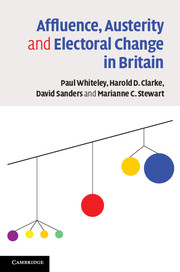Book contents
- Frontmatter
- Contents
- List of Figures
- List of Tables
- Acknowledgments
- 1 The politics of affluence and austerity
- 2 Tony's politics
- 3 Gordon's politics
- 4 ‘I agree with Nick’
- 5 Making political choices
- 6 Bearish Britain
- 7 Choosing how to choose
- 8 Performance politics and subjective well-being
- 9 Valence politics, austerity policies and electoral prospects
- Appendix A Design of the 2010 British election study
- Appendix B Measurement
- Notes
- Bibliography
- Index
9 - Valence politics, austerity policies and electoral prospects
Published online by Cambridge University Press: 05 June 2014
- Frontmatter
- Contents
- List of Figures
- List of Tables
- Acknowledgments
- 1 The politics of affluence and austerity
- 2 Tony's politics
- 3 Gordon's politics
- 4 ‘I agree with Nick’
- 5 Making political choices
- 6 Bearish Britain
- 7 Choosing how to choose
- 8 Performance politics and subjective well-being
- 9 Valence politics, austerity policies and electoral prospects
- Appendix A Design of the 2010 British election study
- Appendix B Measurement
- Notes
- Bibliography
- Index
Summary
In Affluence, Austerity and Electoral Change in Britain we have investigated factors affecting electoral choice and change in modern Britain. Beginning with the landslide 1997 general election that brought Tony Blair's New Labour Party to power, analyses show that the valence politics model that emphasizes party performance judgments, party leader images and flexible partisan attachments does much to account for voting decisions and patterns of party support in inter-election periods. Spatial models of party competition that focus on distances between parties and voters on positional issues dividing the electorate are relevant, but their effects are secondary. Sociological models featuring social class or other sociodemographic characteristics have much weaker effects. As discussed in Chapters 2 and 3, the valence politics model dominated throughout the Blair years and its explanatory power continued unabated during Gordon's Brown's premiership.
Chapters 4 and 5 demonstrate that valence politics considerations also did much to shape the choices voters made in the 2010 general election – the contest that ended the New Labour era and set the stage for a Conservative–Liberal Democrat Coalition Government. The impact of leader images was dramatically illustrated by the first-ever leaders’ debate when voters’ highly favourable reactions to Nick Clegg's performance boosted the Liberal Democrats’ standing in the polls and reconfigured the election campaign. Analyses show that both the Air War – the national campaign in the media – and the Ground War – local campaigns across the country – were important for understanding voting behaviour in 2010.
- Type
- Chapter
- Information
- Affluence, Austerity and Electoral Change in Britain , pp. 252 - 282Publisher: Cambridge University PressPrint publication year: 2013



